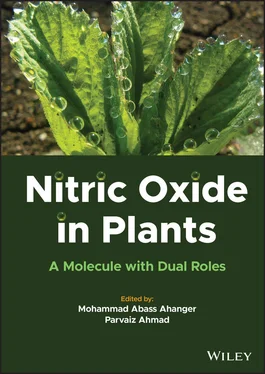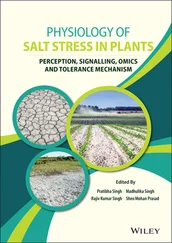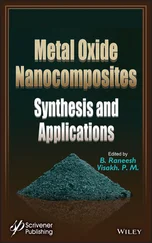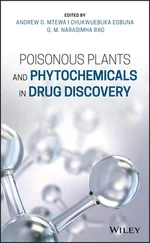Nitric Oxide in Plants
Здесь есть возможность читать онлайн «Nitric Oxide in Plants» — ознакомительный отрывок электронной книги совершенно бесплатно, а после прочтения отрывка купить полную версию. В некоторых случаях можно слушать аудио, скачать через торрент в формате fb2 и присутствует краткое содержание. Жанр: unrecognised, на английском языке. Описание произведения, (предисловие) а так же отзывы посетителей доступны на портале библиотеки ЛибКат.
- Название:Nitric Oxide in Plants
- Автор:
- Жанр:
- Год:неизвестен
- ISBN:нет данных
- Рейтинг книги:5 / 5. Голосов: 1
-
Избранное:Добавить в избранное
- Отзывы:
-
Ваша оценка:
- 100
- 1
- 2
- 3
- 4
- 5
Nitric Oxide in Plants: краткое содержание, описание и аннотация
Предлагаем к чтению аннотацию, описание, краткое содержание или предисловие (зависит от того, что написал сам автор книги «Nitric Oxide in Plants»). Если вы не нашли необходимую информацию о книге — напишите в комментариях, мы постараемся отыскать её.
Examines the beneficial roles of nitric oxide in growth and stress tolerance regulation through its involvement in tolerance mechanisms Nitric Oxide in Plants: A Molecule with Dual Roles
Nitric Oxide in Plants: A Molecule with Dual Roles
Nitric Oxide in Plants — читать онлайн ознакомительный отрывок
Ниже представлен текст книги, разбитый по страницам. Система сохранения места последней прочитанной страницы, позволяет с удобством читать онлайн бесплатно книгу «Nitric Oxide in Plants», без необходимости каждый раз заново искать на чём Вы остановились. Поставьте закладку, и сможете в любой момент перейти на страницу, на которой закончили чтение.
Интервал:
Закладка:
List of Tables
1 Chapter 1 Table 1.1 The physiological role of NO in plants under abiotic stress.
2 Chapter 2 Table 2.1 Role of nitric oxide (NO) during abiotic stress.
3 Chapter 4Table 4.1 Gene expression mediated by nitric oxide (NO).
4 Chapter 5Table 5.1 Summary of identified nitrate transporters...
5 Chapter 6Table 6.1 Influences of microbes on plants under abiotic stress.
6 Chapter 8Table 8.1 Impact of nitric oxide (NO) on the...Table 8.2 Interactions of different plant...
7 Chapter 10Table 10.1 Mechanisms and effects of nitric...
8 Chapter 13Table 13.1 Influence of NO on antioxidative...
Guide
1 Cover
2 Title page
3 Copyright
4 Table of Contents
5 Preface
6 List of Contributors
7 Begin Reading
8 Index
9 End User License Agreement
Pages
1 i
2 ii
3 iii
4 iv
5 v
6 vi
7 vii
8 viii
9 ix
10 x
11 xi
12 xii
13 xiii
14 xiv
15 1
16 2
17 3
18 4
19 5
20 6
21 7
22 8
23 9
24 10
25 11
26 12
27 13
28 14
29 15
30 16
31 17
32 18
33 19
34 20
35 21
36 22
37 23
38 24
39 25
40 26
41 27
42 28
43 29
44 30
45 31
46 32
47 33
48 34
49 35
50 36
51 37
52 38
53 39
54 40
55 41
56 42
57 43
58 44
59 45
60 46
61 47
62 48
63 49
64 50
65 51
66 52
67 53
68 54
69 55
70 56
71 57
72 58
73 59
74 60
75 61
76 62
77 63
78 64
79 65
80 66
81 67
82 68
83 69
84 70
85 71
86 72
87 73
88 74
89 75
90 76
91 77
92 78
93 79
94 80
95 81
96 82
97 83
98 84
99 85
100 86
101 87
102 88
103 89
104 90
105 91
106 92
107 93
108 94
109 95
110 96
111 97
112 98
113 99
114 100
115 101
116 102
117 103
118 104
119 105
120 106
121 107
122 108
123 109
124 110
125 111
126 112
127 113
128 115
129 116
130 117
131 118
132 119
133 120
134 121
135 122
136 123
137 124
138 125
139 126
140 127
141 128
142 129
143 130
144 131
145 132
146 133
147 134
148 135
149 136
150 137
151 138
152 139
153 140
154 141
155 142
156 143
157 144
158 145
159 146
160 147
161 148
162 149
163 150
164 151
165 152
166 153
167 154
168 155
169 156
170 157
171 158
172 159
173 160
174 161
175 162
176 163
177 164
178 165
179 166
180 167
181 168
182 169
183 170
184 171
185 172
186 174
187 175
188 176
189 177
190 178
191 179
192 180
193 181
194 182
195 183
196 184
197 185
198 186
199 187
200 188
201 189
202 190
203 191
204 192
205 193
206 194
207 195
208 196
209 197
210 198
211 199
212 200
213 201
214 202
215 203
216 204
217 205
218 206
219 207
220 208
221 209
222 210
223 211
224 212
225 213
226 214
227 215
228 216
229 217
230 218
231 219
232 220
233 221
234 222
235 223
236 224
237 225
238 226
239 227
240 228
241 229
242 230
243 231
244 232
245 233
246 234
247 235
248 236
249 237
250 238
251 239
252 240
253 241
254 242
255 243
256 244
257 245
258 246
259 247
260 248
261 249
262 250
263 251
264 252
265 253
266 254
267 255
268 256
269 257
270 258
271 259
272 260
273 261
274 262
275 263
276 264
277 265
278 266
279 267
280 268
281 269
282 270
283 271
284 272
285 273
286 274
Preface
Plant growth and development is significantly influenced by environmental factors. Due to rapid global climate change both biotic and abiotic stresses have intensified and so have the deleterious effects on normal plant growth and productivity. Environmental stress-mediated decline in plant productivity imparts significant pressure on global food security, and therefore threatens the likelihood of serious food crises in the near future for the increasing world population. Stresses result in oxidative damage through excessive generation of reactive oxygen species (ROS), thereby inducing the oxidation of lipids, proteins, and nucleic acids. Plants have evolved key mechanisms to counteract the damaging effects of stresses. Osmolyte and secondary metabolite accumulation, the antioxidant system, phytochelatin production, ion compartmentation and exclusion, etc. are some of the key mechanisms to counteract the stress factors. All these tolerance mechanisms are regulated at the gene and protein level. Plants exhibiting upregulation of the tolerance mechanisms show better performance in terms of photosynthesis, mineral uptake and assimilation, enzyme functioning, and hence yield productivity. However, it should be mentioned here that enhancing the tolerance potential by employing efficient management practices can be very effective in protecting the yield potential of plants. Every tolerance pathway mentioned above is a combination of many components, which could be organic molecules or enzymes or metabolites. From the past decade onward there has been increasing advocacy for exploiting these individual beneficial molecules to improve the tolerance pathways. In this respect exogenous usage of the key components of tolerance pathways means either foliar or through the roots. Nitric oxide (NO) is a gaseous signaling molecule that was considered toxic for plant metabolism; however, advances in research have confirmed its beneficial role in stress tolerance through its role in signaling and regulation of key developmental events including germination and programmed cell death. Fine-tuned mechanisms elicited by NO have been confirmed through metabolomic, transcriptomic, and proteomic studies. Identification of genes and other key molecules interacting in NO-mediated growth and developmental regulation under stressful conditions is being investigated. Modulations in the endogenous NO concentrations, either through stress exposure or by exogenous application of protectants, confirm the role of NO in plant stress management. In addition, physiological and biochemical studies have confirmed the vital role of optimal NO concentrations in regulation of photosynthesis, carbon assimilation, osmolyte synthesis, antioxidant and secondary metabolite metabolism, and nutrient uptake and assimilation. Interactions with phytohormones like abscisic acid, ethylene, salicylic acid, jasmonic acid, and cross-talk with other signaling molecules have been reported to play pivotal roles in NO-mediated stress tolerance in plants. Keeping in view the above mentioned facts this book is compiled with the aim of providing the scientific community with the latest updates and future goals of NO research. Nitric Oxide in Plants: A Molecule with Dual Roles has 13 chapters, with every chapter having updated information about the relevant topic. The book aims to fill the existing knowledge gap in NO and plant metabolism regulation.
Читать дальшеИнтервал:
Закладка:
Похожие книги на «Nitric Oxide in Plants»
Представляем Вашему вниманию похожие книги на «Nitric Oxide in Plants» списком для выбора. Мы отобрали схожую по названию и смыслу литературу в надежде предоставить читателям больше вариантов отыскать новые, интересные, ещё непрочитанные произведения.
Обсуждение, отзывы о книге «Nitric Oxide in Plants» и просто собственные мнения читателей. Оставьте ваши комментарии, напишите, что Вы думаете о произведении, его смысле или главных героях. Укажите что конкретно понравилось, а что нет, и почему Вы так считаете.












